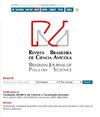Phosphate solubilizing microorganisms in organomineral fertilizers to increase the productivity of Vigna unguiculata (L.) Walp.
IF 1.1
4区 农林科学
Q3 AGRICULTURE, DAIRY & ANIMAL SCIENCE
引用次数: 0
Abstract
This work aimed to evaluate the interaction between P-solubilizing microorganisms and organomineral fertilizers in order to increase the cowpea nutrition and yield under field conditions. One field trial was carried out in a randomized complete block design arranged in subdivided plots (7 x 3) with four replicates. The organominerals (poultry litter, swine manure, filter cake and soot from chimneys) as well as triple superphosphate (TSP) with and without sulfur and the control treatment (no fertilizer addition), were considered the primary factor. The secondary factor was constituted by inoculation of Bradyrhizobium sp. SEMIA 6462 (Simbiose Nod Caupi®), one P-solubilizing bacteria (MBSF2) as well as no inoculation treatment. The MBSF2 inoculation combined to the soot organomineral increased the shoot length at 50 DAE. The stem diameter, shoot and root dry matter at 50 DAE were increased by Bradyrhizobium spp. inoculation and poultry litter. Also, the stem diameter was increased using filter cake organomineral and both inoculants. The nodules number was also increased by use of that organomineral combined to Bradyrhizobium spp.有机肥中增磷微生物提高马蹄铁产量的研究Walp。
本研究旨在探讨溶磷微生物与有机肥的相互作用,以期在田间条件下提高豇豆的营养和产量。1个田间试验采用随机完全区组设计,按细分样地(7 × 3)进行,共4个重复。有机矿物(禽畜粪便、猪粪、滤饼和烟囱烟尘)、含硫和不含硫的三元过磷酸酯(TSP)以及对照处理(不添加肥料)被认为是主要影响因素。次要因子为接种缓生根瘤菌SEMIA 6462 (Simbiose Nod Caupi®)和一种p溶菌(MBSF2),不接种处理。在50 DAE时,接种MBSF2与烟灰有机化合物结合可使苗长增加。接种缓生根瘤菌和家禽凋落物均可增加50 DAE时的茎粗、茎部和根干物质。同时,添加滤饼有机化合物和两种接种剂均可增加茎粗。该有机肥与缓生根瘤菌配伍后,根瘤数也增加。
本文章由计算机程序翻译,如有差异,请以英文原文为准。
求助全文
约1分钟内获得全文
求助全文
来源期刊

Brazilian Journal of Poultry Science
农林科学-奶制品与动物科学
CiteScore
1.80
自引率
9.10%
发文量
60
审稿时长
>12 weeks
期刊介绍:
A Revista Brasileira de Ciência Avícola surgiu em 1999 a partir da necessidade que a comunidade científica possuía de um periódico para veiculação e publicação de seus trabalhos, com a publicação de três números anuais.
A Revista conta hoje com um corpo editorial altamente qualificado e com artigos científicos desenvolvidos pelos maiores especialistas da área, o que a cada dia atrai mais leitores em busca de inovação e respaldo técnico.
Devido à credibilidade que conquistou pelos esforços de sus autores, relatores e revisores, a Revista ganhou caráter de coleção, sendo consultada como fonte segura de estudo desenvolvidos na Avicultura.
A partir de 2003 – volume 5 -, a Revista passou a chamar-se Brazilian Journal of Poultry Science, e todos os trabalhos passaram a ser publicados em inglês. No mesmo ano subiu para quatro o número de revistas por volume, ampliando-se assim os trabalhos publicados anualmente.
 求助内容:
求助内容: 应助结果提醒方式:
应助结果提醒方式:


